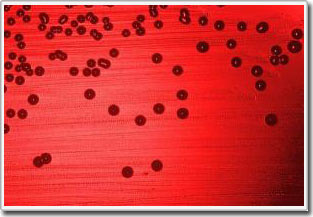Bacteria that wear 'invisibility cloak' escape the human immune system
University of York scientists have described this as an important step in the mechanism of bacteria used to avoid our immune system.
" Invisibility cloak " here means bacteria like Haemophilus influenzae, the underlying cause of ear infections in children, can move in the body without fear of being attacked by the immune system. Research from York University's Department of Biochemistry has studied how molecular capture bacteria are used to create a " coat ", called sialic acid.

Blood sample Agar implanted Haemonphilus inflenzae bacteria (Photo: CDC)
Researchers have discovered an enzyme activity that helps to capture more efficiently the sialic acid secreted from our cell surface.Using sialic acid to create an ' invisibility cloak ', some other bacteria also use the same method to capture sialic acid as a simple food source , or literally they are eroding us from inside.
Dr Gavin Thomas, of the Department of Biology, who led the study, said: 'This novel enzyme mechanism, as well as other steps needed for the creation of the "invisibility cloak" that we just found. In York, it's also the opportunity to develop a new drug against these bacteria. '
The study was funded by the Science Council on Biotechnology Research, and was conducted by Dr. Emmanuele Severi (Thomas Biological Laboratory) in collaboration with Dr. Jennifer Potts (Biochemistry), Dr. Andrew Leech (Biology), Professor Keith Wilson and Dr. Axel Müller (York Biological and Chemical Laboratory).
The research team was supported by the Center for Magnetic Resonance at the Department of Chemistry, besides the Department of Biology's technology equipment room. Article ' The multiplicity of sialic acid catalyzed by Escherichia coli ß-Propeller protein' has just been published in Biological Chemistry.
- Show the first ultra-thin invisibility shirt
- Stealth laser cloak helps Earth escape aliens
- The US is producing thousands of invisibility cloaks
- Strange technology: Austrian 'stealth' time
- Why is invisibility cloak hard to come true?
- Technology made invisibility cloak with invisible beam
- Invisibility cloaks are coming true
- Invisibility cloak is about to come true
- Perfect invisibility
- The discovery caused a stir in a microbial system that lives right in the human brain
- Harry Potter's invisibility cloak can become a reality
- Close-up of the human body's immune system is beautiful
 Why do potatoes have eyes?
Why do potatoes have eyes? 'Tragedy' the world's largest carnivorous life: Death becomes ... public toilet
'Tragedy' the world's largest carnivorous life: Death becomes ... public toilet Tomatoes were once considered 'poisonous' for 200 years
Tomatoes were once considered 'poisonous' for 200 years Detecting microscopic parasites on human face
Detecting microscopic parasites on human face